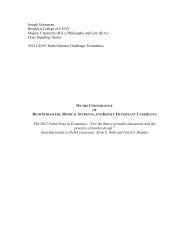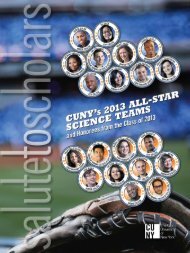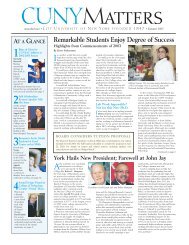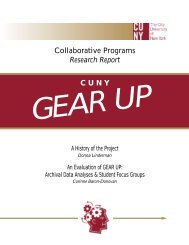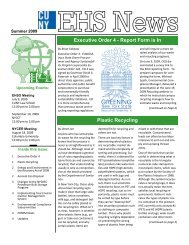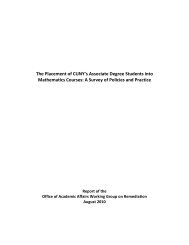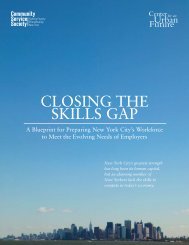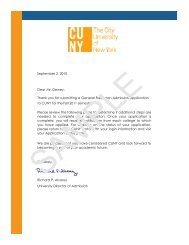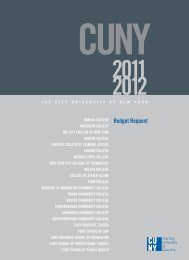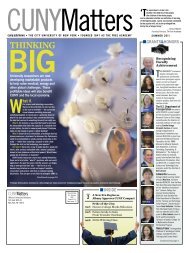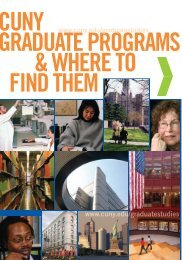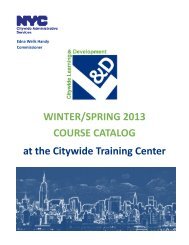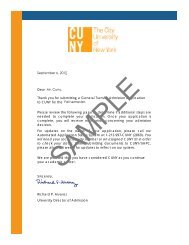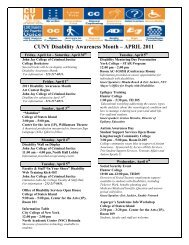CUNY Master Plan 2012-2016
CUNY Master Plan 2012-2016
CUNY Master Plan 2012-2016
Create successful ePaper yourself
Turn your PDF publications into a flip-book with our unique Google optimized e-Paper software.
THE MISSION PART FOUR:<br />
The University Must Remain Responsive to the Needs of its Urban Setting<br />
“<br />
The university must remain responsive to the needs of its urban setting,” states Section 6201 of<br />
the New York State Education Law. Shortly thereafter, the law reiterates: “Only the strongest<br />
commitment to the special needs of an urban constituency justifies the legislature’s support of<br />
an independent and unique structure.” This section of the <strong>Master</strong> <strong>Plan</strong> focuses on the myriad ways in<br />
which the University remains steadfastly responsive to the needs of its urban setting and urban constituency,<br />
while simultaneously fueling New York’s social and economic engines in ways that were<br />
undoubtedly not envisaged when the law was drafted in 1961. Indeed, if New York City is at the beating<br />
heart of the state’s economic development, <strong>CUNY</strong> provides the sustaining muscle and lifeblood.<br />
The importance of New York City to the health of New York State has been clearly expressed in the<br />
New York City Economic Development Council’s Strategic <strong>Plan</strong> (co-chaired by <strong>CUNY</strong> Chancellor<br />
Matthew Goldstein), which described New York City as “the state’s primary economic engine.” However,<br />
the city faces significant challenges, with one-fifth of its residents living below the federal poverty line.<br />
“This, along with aging infrastructure, a shortage of affordable housing and continuing challenges in public<br />
education, generates outsized demands on the local tax base, which are exacerbated by reductions in<br />
state and federal aid. As a result, New York is among the most heavily taxed cities in America.” Add to this<br />
the pressure of increasing global competition, and it isn’t difficult to see another layer of challenge facing<br />
the portion of the city’s population that is “unprepared to participate in the modern workforce and,<br />
therefore, chronically unemployed or earning less than required to enjoy a reasonable standard of living.”<br />
In meeting this challenge, <strong>CUNY</strong> is essential.<br />
The New York City Regional Council’s Strategic <strong>Plan</strong> is based on four key pillars: improving quality of<br />
life; creating a pro-growth, pro-jobs environment; investing in the future; and fostering innovation and<br />
inter-regional cooperation. These pillars depend on prominent industries and large institutions—including<br />
<strong>CUNY</strong>—to build on the city’s multiple strengths, “while ensuring that economically distressed communities<br />
and populations have greater opportunities to participate in the benefits of that growth.” That<br />
message resounds throughout this section of the <strong>CUNY</strong> <strong>Master</strong> <strong>Plan</strong>. 9<br />
9<br />
New York City Regional Economic Development Council, Strategic <strong>Plan</strong>, 2011. Available at<br />
http://nyworks.ny.gov/themes/nyopenrc/rc-files/nyc/REDECFINALNYC.pdf<br />
71



